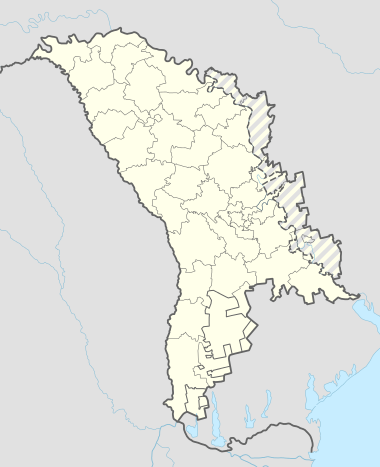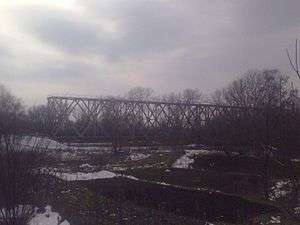Ungheni
Ungheni (Romanian pronunciation: [uŋˈɡenʲ]) is a municipality[2] in Moldova. With a population of 35,157, it is the seventh largest town in Moldova and the seat of Ungheni District.
Ungheni | |
|---|---|
City | |
 Alexander Nevsky Cathedral | |
 Flag  Coat of arms | |
 Ungheni Location within Moldova | |
| Coordinates: 47°13′N 27°49′E | |
| Country | Moldova |
| County | Ungheni District |
| Government | |
| • Mayor | Alexandru Ambros |
| Area | |
| • Total | 16.4 km2 (6.3 sq mi) |
| Population | |
| • Total | 30,804 |
| • Density | 1,900/km2 (4,900/sq mi) |
| Time zone | UTC+2 (EET) |
| • Summer (DST) | UTC+3 (EEST) |
| Website | http://ungheni.md/ |
There is a bridge across the Prut and a border checkpoint to Romania. There is another border town with the same name in Romania (Ungheni, Iași), on the other side of the Prut River.
History
The first historical mention of Ungheni dates to 20 August 1462. A railway between Ungheni and Chişinău was built in 1875 by Russia in preparation for the Russo-Turkish War (1877–1878). After World War II, the rail route through Ungheni became the main connection between the USSR and Romania.
Features and attractions
Gustave Eiffel bridge
In 1876 after the spring flooding of the river Prut, the railway bridge that linked Moldova and Romania was almost destroyed. The Railways Department invited Gustave Eiffel to Bessarabia (Moldova) to redesign and rebuild the bridge. Today, it remains a strategic structure under the supervision of border guards.
Media
- Unghiul
- Expresul de Ungheni
- Euronova TV
- UNGHENI.TV
- Radio Chişinău 93.8 FM
- Vocea Basarabiei 100.1 FM
Natives
| Year | Pop. | ±% |
|---|---|---|
| 1959 | 12,595 | — |
| 1970 | 19,558 | +55.3% |
| 1979 | 27,062 | +38.4% |
| 1989 | 37,788 | +39.6% |
| 2004 | 35,311 | −6.6% |
| 2012 est. | 38,100 | +7.9% |
- Anatolie Arhire
- Constantin Bejenaru
- I. A. L. Diamond
- Valentina Naforniţă
- Octavian Țîcu
- Vanotek
International relations
Consulates
- Romania – Consulate
Gallery
 The first historical mention of Ungheni dates to 20 August 1462
The first historical mention of Ungheni dates to 20 August 1462 Ungheni river port
Ungheni river port Mihai Eminescu statue
Mihai Eminescu statue
References
- Results of Population and Housing Census in the Republic of Moldova in 2014: "Characteristics - Population (population by communes, religion, citizenship)" (XLS). National Bureau of Statistics of the Republic of Moldova. 2017. Retrieved 1 May 2017.
- LEGE Nr. 248 din 03.11.2016 pentru modificarea și completarea Legii nr. 764-XV din 27 decembrie 2001 privind organizarea administrativ-teritorială a Republicii Moldova (in Romanian)
- Sister Cities Winston-Salem. City of Winston-Salem.
- Winston-Salem, NC Archived 23 March 2017 at the Wayback Machine. Interactive City Directory. Sister Cities International, Inc.
- Brezianu, Andrei and Spânu, Vlad (eds.) (2007) "Ungheni" Historical Dictionary of Moldova (2nd ed.) Scarecrow Press, Lanham, Maryland, USA, p. 371, ISBN 978-0-8108-5607-3
| Wikimedia Commons has media related to Ungheni. |
